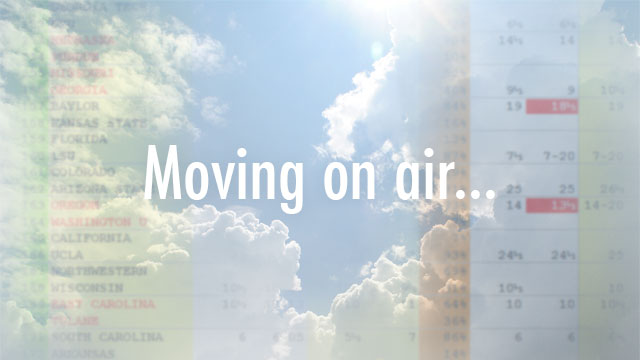Money isn’t the only thing that moves the lines.
These days, the majority of sportsbooks adjust their point spreads simply because other books have, not necessarily because they took a big bet. It’s called “moving on air” and is a hot-button topic among bettors and bookies.
The line on last month’s Alabama-Texas A&M game is a good example. Heading into game week, Alabama was a 7.5-point favorite at most Vegas shops. However, after prominent online book Pinnacle opened the Crimson Tide as 9.5-point favorites, a Vegas book readjusted its number to 9.5 and admitted to not taking a bet. The adjustment was made completely “on air.”
When books move on air, bettors can be positively or negatively affected.
- Positive: If a bettor is trying to manipulate a line, or wanting to fade someone else’s move, then certainly books moving on air is a good thing.
- Negative: A bettor trying to chase steam on something he already liked will find it far more difficult if books are moving on air.
Moving on air rarely, if ever, took place before the advent of the odds screen. But the screen changed everything—it changed how bettors bet and how bookmakers booked—and brought things like line manipulation and fakes into the cat-and-mouse game.
Longtime sports betting company Don Best published its first odds screen in 1990. Now, there are dozens of websites and services offering odds feeds. Bettors and books have discovered different ways of using them.
Knowing books will move lines to match the market consensus on the screen, big bettors will often bet into the opposite side of the line they truly like at an influential book. The idea is to inflate the line and hope other books move on air to match the new number. Then, the bettor can bet the other side of the game at the better number.
Pre-screen days
In the pre-Screen days, the Stardust sportsbook was the home of the first football lines on the planet. Bettors would line up 10-deep at four windows to take $1,000 whacks at the virgin spreads. Meanwhile, a different set of people would rush outside of the book to make a call.
“There were a lot of outfits that would sit in the book and wait for the numbers to go up,” said former Caesars and Mirage sportsbook director Richie Baccellieri. “Then, they went out and made phone calls to everyone else and tell them what odds the Dust was using. Anybody who was bookmaking would take those odds, and those would be their numbers. Now, everyone uses CRIS (Bookmaker).
“The perception of the screen has changed in the last 15 years,” Baccellieri added. “Bookmakers used to use it as a tool to see where other bookmakers are at with their line. Now, it’s turned into ‘where I need to be with my line,’ when that’s not the case. If you told me CRIS and Pinnacle were 100 percent of the time at the right number, I’d say use their numbers. But they’re taking bets to get to their numbers. You want to encourage action, not discourage it.”
Roxy Roxborough, a legendary figure in the Vegas sports betting industry, was the founder of the Las Vegas Sports Betting Consultants. He created one of the first odds feeds and provided the opening odds to the Stardust. Roxborough now lives overseas, but is still active in the global sports betting market. He sees both sides of “moving on air.”
“Suppose you are running a sportsbook, and you close the shop at night with Alabama -7.5,” Roxborough said. “You open later than most books the next morning and so the next day you see everyone has the game -9. You would be crazy to leave it at -7.5 and give away free points when you know someone is willing to lay -8.5. So you should open at -8.5, take a bet and get to the consensus.
“Now as for moving the odds ‘on air’ in real time, that is a question of ‘How much risk you are willing to take as a bookmaker,’” he added. “If your management has no tolerance for risk then it might make sense. But if you want to pay the light bills you have to take some bets. The cost of getting middled and sided usually makes taking a bet and moving faster a more profitable strategy than just moving on no action. Of course, bettors don’t like it. They prefer to be able to pick off slow-moving numbers or stale lines when new information becomes available. But this isn’t a slow-motion world anymore.”
To one oddsmaker at a prominent offshore sportsbook, “moving on air” means anticipating his clientele’s betting and adjusting his lines accordingly.
“Such a move is not for the novice bookmaker,” the oddsmaker said. “You really have to know your client base and have the stones to ride it out if someone sharp comes in and takes the value. If you take a large bet on your value side before your anticipated action comes in, you can’t cut and run or you’ll leave yourself open for a bad middle.”
